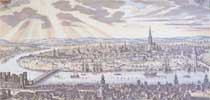
Seville History
The earliest beginnings of the city of Seville can be traced back to when the Turdetans, an Iberian tribe originally from Tartessos, founded a small settlement called Ispal on the banks of the River Guadalquivir in the 8th century BC. The inhabitants quickly developed a flourishing trade, which attracted travellers from many different places, particularly Greeks, Phoenicians and Carthaginians.
The small town was razed in the 2nd century BC by the Carthaginians and was not rebuilt until the Romans arrived. In around 216 BC, the Carthaginian armies took over the city. The Second Punic War fought between Rome and Carthage led to Baetica falling under Roman rule in 206 BC, when the Romans won a decisive victory at the Battle of Ilipa.

The Romans named the city Hispalis and began to rebuild it, constructing Itálica, the first Roman settlement on the Iberian Peninsula, which can still be visited today.
In 49 BC Hispalis was growing and began to be considered one of Baetica's main cities, when Julius Caesar ordered walled fortifications to be built and gave it the status of a Roman colony. It became increasingly important, at the expense of Itálica, and was eventually recognised by Rome as the most important city in the Spain of that time.
In 712 the city was occupied by the Arabs under the command of the Moorish leader Musa ibn Nusayr, who brought Islamic rule to Seville. The name of the city was once again changed from the Roman Hispalis to Isbiliya, and the river was given its current name, Guad-al-Quivir, which means "the big river". The Moors introduced a new way of life in the city, although the Roman people preserved many of the traditions that they had established as they began to adapt to everyday life in an Islamic city.
The year 1492 marked the beginning of the Modern Age, and the Discovery of the New World saw Seville thrown into the role of port and gateway to the Americas. This led to an economic boom that generated remarkable wealth in the city, thanks to new markets in the Americas, and made Seville the trading mecca of the Western world, attracting numerous merchants, important bankers, foreigners, artists and, of course, sailors in search of adventure.
With the discovery of America, Seville became the nerve centre for trade with the New World, giving rise to the construction of a number of emblematic buildings in the city, including the Archives of the Indies (Archivo de Indias), the Chamber of Commerce (Casa de Contratación) and the Santa María de Jesús College, which formed part of the early University of Seville.
In the 17th century Seville fell prey to a serious economic crisis affecting Europe in general and Spain in particular. In spite of the economic decline, however, art flourished in all its forms. Velázquez, and later Murillo, marked the zenith of the Sevillian school of art. The burgeoning religious fervour led to an impressive production of processional imagery. The Hospital de Venerables Sacerdotes and the San Telmo Seminary also date to this period.
The 19th century did not get off to a good start for the city. In 1800 an outbreak of yellow fever spread like wildfire through Seville, killing a third of the population in a period of just four months. The French invasion, some years later, brought Seville under Napoleonic rule, although it remained one of the most fiercely anti- Napoleonic cities.
In 1833, soon after Isabella II had been declared the legitimate heir to the throne of Spain, the administrative province of Seville was created. The disentailment carried out by Mendizábal in 1835 resulted in speculative gains for the few and the loss of a significant part of the city's artistic heritage as churches and convents disappeared. The reign of Isabella II witnessed a construction boom, led by the bourgeoisie. The drive for renovation resulted in the construction of Isabel II Bridge, better known as Triana Bridge. Architecture flourished in the early decades of the 20th century. The 1929 Ibero-American Exposition filled Seville with interesting regionalist buildings and monuments, such as the Plaza de España.
1992 was another landmark year in the history of the city. The 1992 Seville Universal Exposition is the most significant event in Seville's current chapter of history. In order to stage the event, the city undertook an ambitious plan to transform and modernise its urban infrastructure and services. On the threshold of a new century, Seville has once again been required to meet the challenge of renovating its urban design to accommodate the needs of the city in coming years.
Seville Spain information



